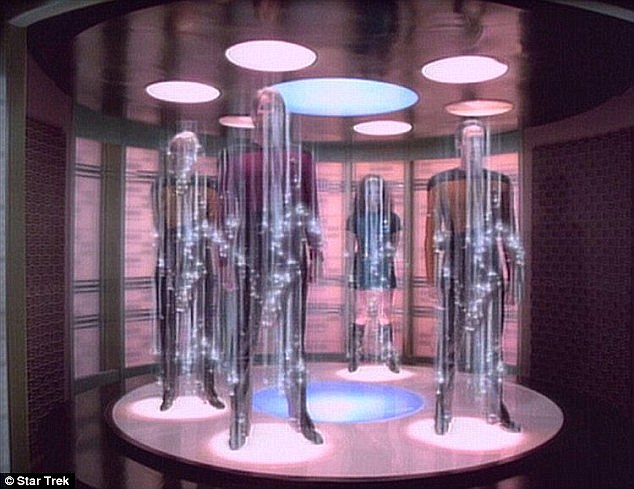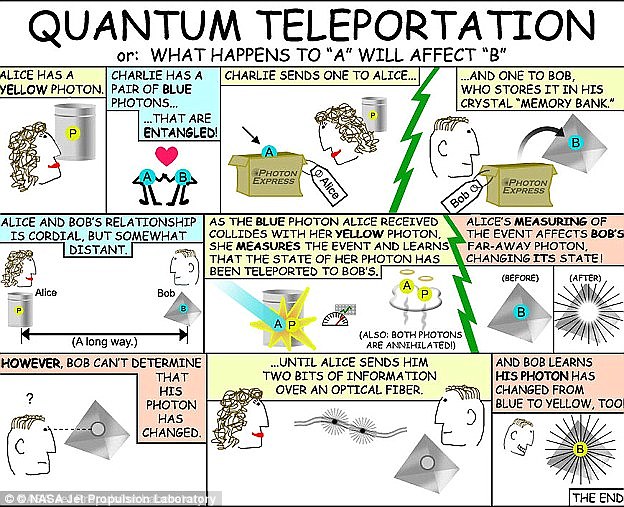Quantum teleportation breakthrough as scientists send data across cities - and it could lead to UNBREAKABLE encryption for computer networks
- Quantum teleportation involves sending quantum information using light
- State of a particle is destroyed at one location but imprinted on another
- Two separate studies have shown this is now feasible across several miles
- This new research is a step towards building a faster 'quantum Internet'
- The breakthrough could lead to more secure internet banking
While Star Trek-style teleportation is still a long way off, researchers have revealed a major breakthrough in the field of quantum travel.
Two separate teams have transferred quantum information over several miles of fibre optic networks in an urban network.
The results could lead to more secure bank accounts, a faster internet and possibly even open the door to the controversial idea of human teleportation.
Scroll down for video

One of the potential applications for quantum teleportation is a network of quantum computers (illustrated) and a 'quantum internet' that is far faster and much more secure than current networks
Quantum teleportation depends on a phenomenon called quantum entanglement, which allows connections to be made between atoms, with their information being sent to others far away.
The entangled particles are connected in such a way that the action of one directly affects the others, even if they are separated over large distances.
Albert Einstein called this 'spooky action at a distance.'
Previous studies have shown atoms teleporting across a room, and light being teleported across the Danube River in Austria.
Now two separate studies, published today in Nature Photonics, have shown quantum teleportation is feasible through optical fibres across cities.
The new research is a step towards building a 'quantum internet', which would be faster, more efficient and more secure than the networks we rely on today.

Human teleportation was a feature seen in Star Trek (pictured). Some experts have said breakthroughs in quantum teleportation could eventually lead to human teleportation
Quantum teleportation seems like science fiction in the sense that the state of a particle is destroyed at one location but imprinted on another remote system - without the two particles ever interacting.
Long-distance quantum teleportation using a fibre network is more secure than through the air, but it requires independent light sources, and this presents a technological challenge.
The light beam from one source needs to stay indistinguishable to the light beam from the other source after travelling through several miles of fibre.
In one study, researchers from the University of Science and Technology of China in Shanghai demonstrated the effect over optical fibres in Hefei, China.
In the second, researchers from the University of Calgary designed another set-up to demonstrate the effect in Calgary, Canada.
Each of these experiments is split over three distinct locations, traditionally named Alice, Charlie and Bob, to mimic the structure of future quantum networks.
The two experiments separately demonstrated using optical fibres for quantum teleportation is possible across the length of cities.
The Calgary study was able to demonstrate the effect across an urban fibre network measuring 3.8 miles (6.2km).
In theory, the technique could be scaled up to work across any distance, which could lead to the development of a fibre-based quantum internet connecting major cities.
'Combined, these two experiments clearly show that teleportation across metropolitan distances is technologically feasible, and undoubtedly many interesting quantum information experiments in the future will be built on this work,' said Frederic Grosshans, writing in an accompanying Nature article.
Grosshans, a researcher in quantum computing at the National Centre for Scientific Research in Paris, was not involved in the research.
The results of the two papers could have implications for cryptography, which involves transmitting information securely, including communications between Earth and spacecraft.
For example, if Nasa is communicating with astronauts on Mars, it will not want to have hackers break the encrypted channel and give them false information.
Quantum teleportation can also be used to make systems such as bank accounts more secure over longer distances.
'Undoubtedly many interesting quantum information experiments in the future will be built on this work,' said Grosshans.
'For the longer term, the two papers demonstrate that the possibility of quantum networks that span a city are a realistic proposition, which is an exciting vision for the future.'
'A relatively near term application would be some variety of quantum cryptography,' Grosshans told MailOnline.
'Allowing communications secure against future technical progress, the messages cannot be recorder and decrypted by a powerful computer in the future.
'I can imagine this kind of applications be used in 10 to 20 years or never, depending on the evolution of classical cryptography and the research on quantum computer.'
One possible result of this research is human teleportation.

Professor Michio Kaku (pictured) has previously said the breakthroughs needed to transport humans instantly have already been made. He believes a teleporter could become a reality as soon as the end of the century
Professor Michio Kaku has previously said the breakthroughs needed to transport humans instantly have already been made.
He believes a teleporter could become a reality as soon as the end of the century and it's only a matter of time before we will be 'beaming' across the universe.
The physicist is a professor at City University in New York.
'You know the expression "Beam me up Scotty"? We used to laugh at it,' he said.
'We used to laugh when someone talked about teleportation, but we don't laugh anymore.'
'Quantum teleportation already exists [and] I think within a decade we will teleport the first molecule.'
He continued that, as humans we already do this at an atomic level, reports The Express.
Once scientists have successfully teleported molecules, Dr Kaku believes the next step will be to send photons to a lunar base before experimenting with larger objects, animals and eventually humans.
Most watched News videos
-
 'I'll fight you for the kids': 'Furious' Brad Pitt attacks...
'I'll fight you for the kids': 'Furious' Brad Pitt attacks...
-
 'I'm sure their wives and mothers would be proud': Disabled...
'I'm sure their wives and mothers would be proud': Disabled...
-
 Now you CAN take your children on holiday in termtime...
Now you CAN take your children on holiday in termtime...
-
 'And that, my friends, is what they call closure':...
'And that, my friends, is what they call closure':...
-
 They are trying to kill you… so would you know how to...
They are trying to kill you… so would you know how to...
-
 Angelina Jolie and her high-powered team are holed-up in...
Angelina Jolie and her high-powered team are holed-up in...
-
 Family flee their home after finding dozens of spiders in...
Family flee their home after finding dozens of spiders in...
-
 Mother left terrified son, 2, alone in car until after...
Mother left terrified son, 2, alone in car until after...
-
 So what WOULD your fathers say, girls? Students wearing...
So what WOULD your fathers say, girls? Students wearing...
-
 'I'd go into the bedroom and find Dad in bed with three...
'I'd go into the bedroom and find Dad in bed with three...
-
 EXCLUSIVE: Angelina Jolie was so jealous of Marion Cotillard...
EXCLUSIVE: Angelina Jolie was so jealous of Marion Cotillard...
-
 Investment scam where staff are ordered to 'rape clients out...
Investment scam where staff are ordered to 'rape clients out...











































































































































































































 Is sugar REALLY that bad for you? The biggest food myths debunked - as a new show aims to separate food fact from fiction
Is sugar REALLY that bad for you? The biggest food myths debunked - as a new show aims to separate food fact from fiction
Charlie, Glasgow, United Kingdom, 22 hours ago
Wait until the Russian hackers hear about it.